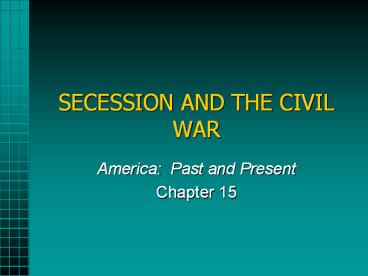SECESSION AND THE CIVIL WAR - PowerPoint PPT Presentation
Title:
SECESSION AND THE CIVIL WAR
Description:
America: Past and Present Chapter 15 The Storm Gathers Secession does not necessarily mean war One last attempt to reconcile North & South Federal response to ... – PowerPoint PPT presentation
Number of Views:140
Avg rating:3.0/5.0
Title: SECESSION AND THE CIVIL WAR
1
SECESSION AND THE CIVIL WAR
- America Past and Present
- Chapter 15
2
The Storm Gathers
- Secession does not necessarily mean war
- One last attempt to reconcile North South
- Federal response to secession debated
3
The Deep South Secedes
- December 20,1860--South Carolina secedes
- February 1861--Confederate States of America
formed - included South Carolina, Georgia, Florida,
Alabama, Mississippi, Louisiana, and Texas
4
Secession
5
The Deep South Secedes (2)
- Government headed by moderates
- Confederate constitution resembles U.S.
- Aim to restore pre-Republican Party Union
- Southerners hope to attract Northern states into
Confederacy
6
The Failure of Compromise
- Crittenden Plan extend the Missouri Compromise
line to the Pacific - Lincoln rejects
- does not think it will end secession
- viewed as repudiation of Republican principles
- Buchanan takes no action to stop secession
- Some wish to let the South depart in peace
7
And the War Came
- North seeks action to preserve Union
- April 13, 1861--Fort Sumter, S.C, falls
- April 15--Lincoln calls out Northern state
militias to suppress Southern insurrection - April-May--Upper South secedes
- Border states--slave states remain in Union
- War defined as effort to preserve Union
8
Adjusting to Total War
- North must win by destroying will to resist
- Total War--a test of societies, economies,
political systems as well as armies
9
Resources of the Union and the Confederacy, 1861
10
Prospects, Plans, and Expectations
- South adopts defensive strategy--North must fight
in unfamiliar, hostile terrain - Lincoln adopts two-front strategy
- capture Confederate capital, Richmond, Va.
- seize control of the Mississippi River
- deploy navy to blockade Southern ports
11
Overview of Civil War Strategy
12
Mobilizing the Home Fronts
- 1862--North South begin conscription
- Northern mobilization
- finance war through taxes, bonds, paper money
- private industry supplies Union armies well
- Confederate mobilization
- government arsenals supply Confederate armies
- efforts to finance lead to runaway inflation
- transportation system inadequate
13
Political Leadership Northern Success and
Southern Failure
- Lincoln expands wartime powers
- declares martial law
- imprisons 10,000 "subversives" without trial
- briefly closed down a few newspapers
- Jefferson Davis
- concerned mainly with military duties
- neglects civilian morale, economy
- lacks influence with state governments
14
Early Campaigns and Battles
- Northern achievements by 1862
- total naval supremacy
- Confederate troops cleared from West Virginia,
Kentucky, much of Tennessee - New Orleans captured
- Confederate achievements by 1862
- stall campaign for the Mississippi at Shiloh
- defend Richmond from capture
15
Civil War, 1861-1862
16
The Diplomatic Struggle
- England
- belligerent rights extended to Confederacy
- conditions recognition of independence on proof
that South can win independence - France--Confederacy not recognized unless England
does so first - "King Cotton" has little influence on foreign
policy of other nations
17
Fight to the Finish
- North adopts radical measures to win
- 1863--war turns against South
- Southern resistance continues
18
The Coming of Emancipation
- September 22, 1862--Antietam prompts preliminary
Emancipation Proclamation - surrender in 100 days or lose slaves
- January 1, 1863--Proclamation put into effect for
areas still in rebellion - African Americans flee to Union lines
- Confederacy loses thousands of laborers
19
African Americans and the War
- 200,000 African American Union troops
- Many others labor in Northern war effort
- Lincoln pushes further for black rights
- organizes governments in conquered Southern
states that abolish slavery - Maryland, Missouri abolish slavery
- January 31, 1865--13th Amendment passed
20
The Tide Turns
- May, 1863--war-weariness
- New York riots against conscription
- Grant seems bogged down at Vicksburg
- Union defeated at Chancellorsville
- Democrats attack Lincoln
- July, 1863
- Lee loses Battle of Gettysburg
- Vicksburg falls, North holds the Mississippi
21
Last Stages of the Conflict
- March 9, 1864--Grant made supreme commander of
Union armies - Union invades the South on all fronts
- William Sherman marches through Georgia
- Grant lays siege to Richmond, Petersburg
- September 2--Sherman takes Atlanta
- November 8--Lincoln reelected
22
Civil War, 1863-1865
23
Last Stages of the Conflict
- April 9, 1865--Lee surrenders
- April 14--Lincoln assassinated
- May 26--Final capitulation of Confederacy
24
Effects of the War
- 618,000 troops dead
- Bereft women seek non-domestic roles
- Four million African Americans free, not equal
- Industrial workers face wartime inflation
25
Casualties of War
26
Effects of the War (2)
- Federal government predominant over states
- Federal government takes activist role in the
economy - higher tariffs, free land, national banking
system
27
An Organizational Revolution
- Modern bureaucratic state emerges
- Individualism gives way to organized, cooperative
activity - Catalyst for transformation of American society
in the late nineteenth century































